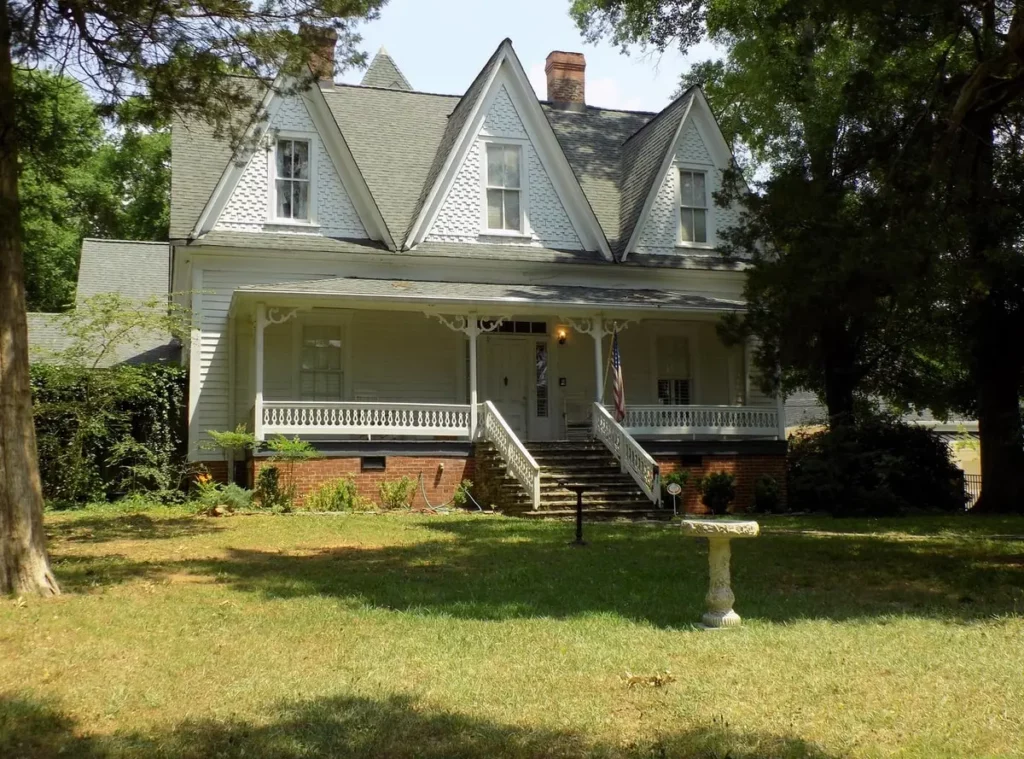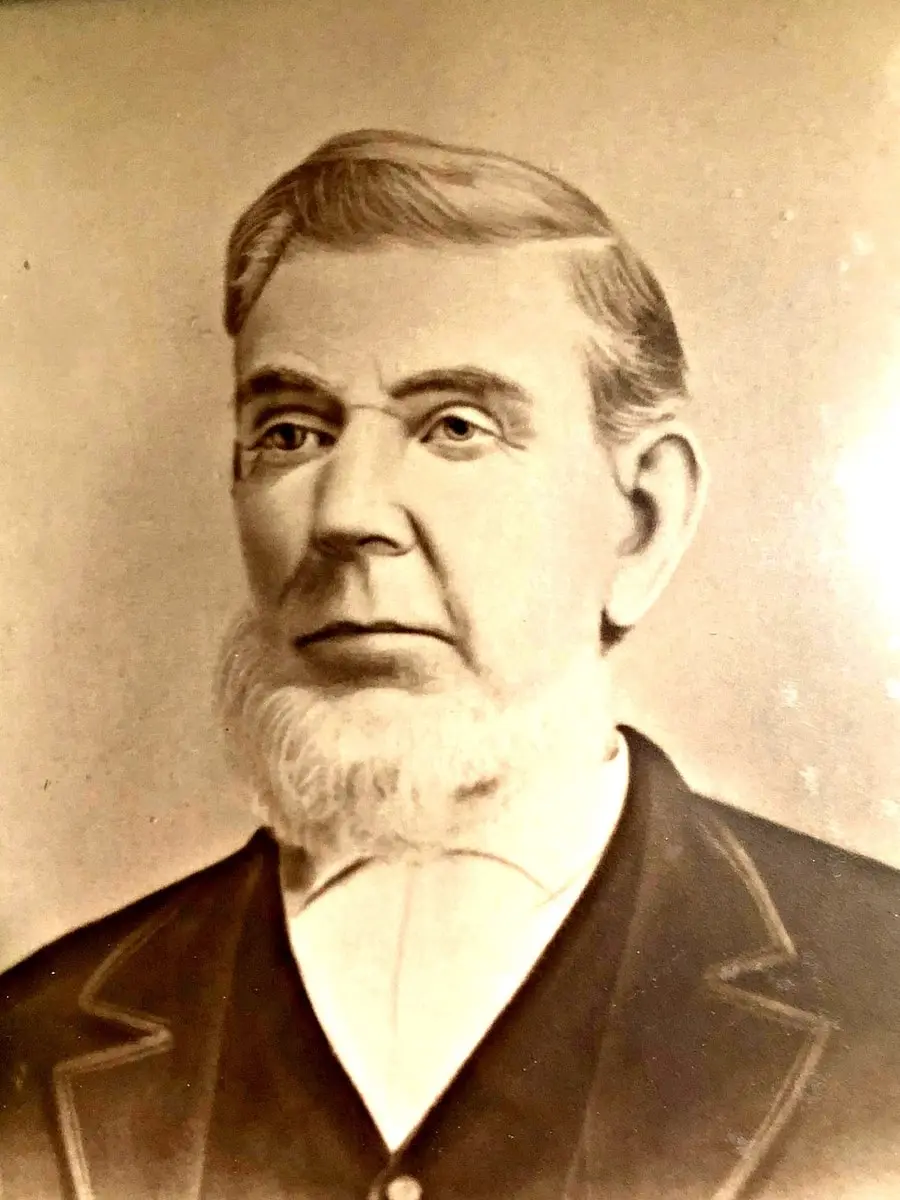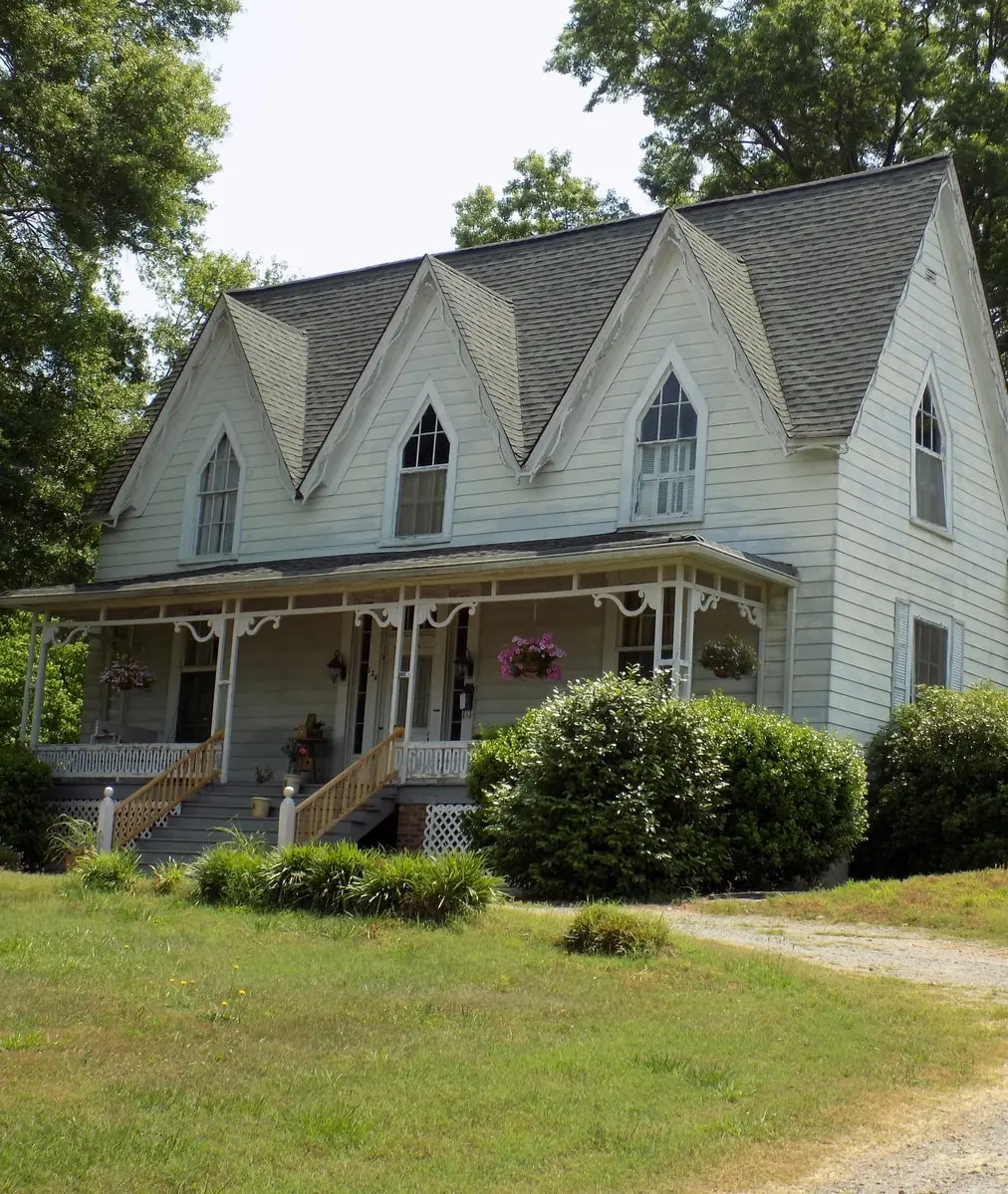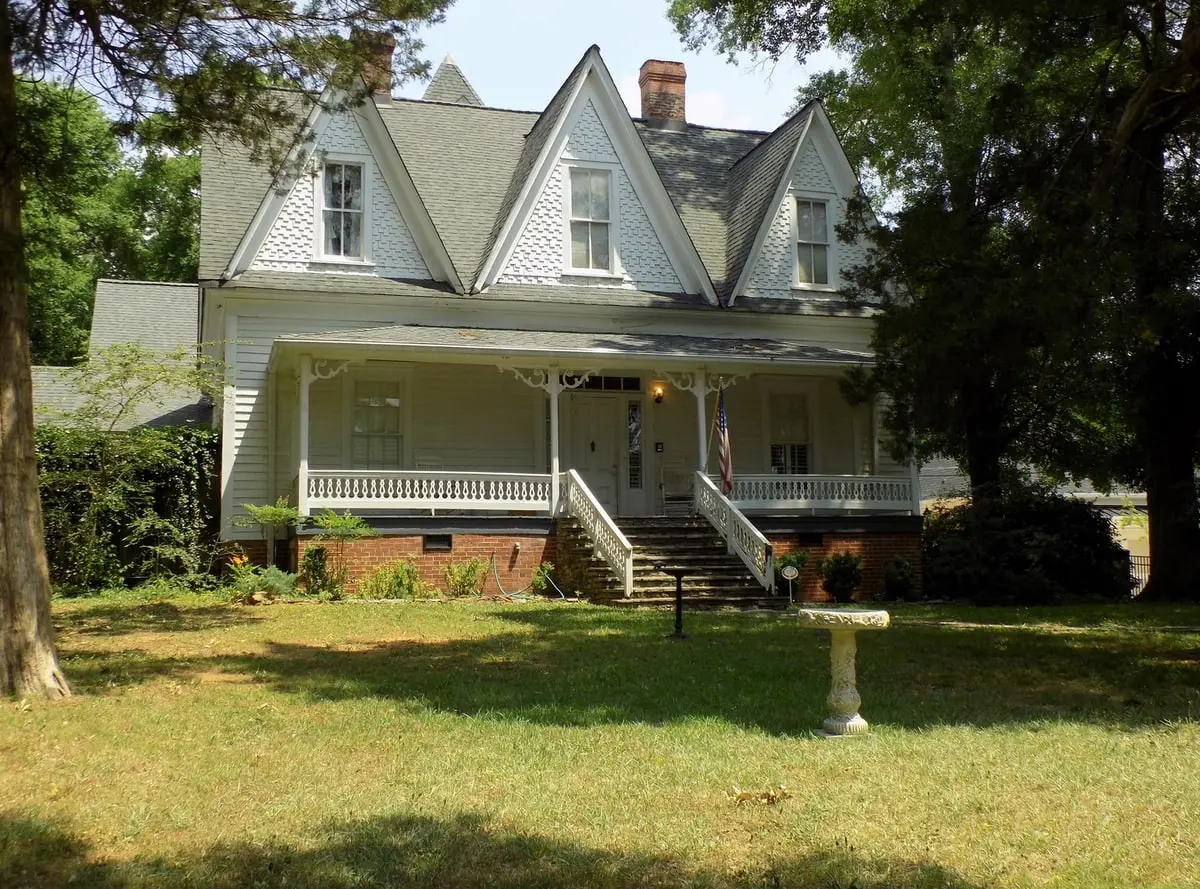They were prominent in the construction industry in Bartow County as early as the 1850s – almost 175 years ago as of 2024. The Jackson brothers left a standing legacy which is visible in many of the wonderful antebellum and post-bellum homes which still grace the landscape of the county even today.
A solitary entry on a page from an ancient receipts book (which, as of this writing in 2022, still hangs on the wall of the Bartow History Center in downtown Cartersville, Georgia) lists the donors to the construction of the first county courthouse in the city. “Milton C. Jackson” is listed among those donors, and, as is explained below, undoubtedly was at least one of the original builders of that historic structure. In fact, he and his brother, Zimri, were instrumental in the construction of a number of the early commercial and residential structures of Bartow.
According to records, Milton was a skilled designer, and the “architect” side of a contracting partnership with his equally-skilled builder-brother, Zimri. Their trademark was large two-story homes with soaring gables and fancy trim-work (“gingerbread”) on the porches and around the eaves of the homes. These homes were also often built with distinctive pointed Gothic Revival windows.
Migration to Georgia
Zimri W. Jackson (1824 -1894), was born in North Carolina, and migrated southward circa 1835-1840 with his father, Thomas Frederick Jackson (1782-1850) and the rest of Thomas Frederick’s family to the tiny north Georgia mountain community of Hinton. At that time, Hinton was located in what then was Gilmer County, but what later (1853) was incorporated into Pickens County, Georgia.
By the time of the 1850 Federal Census of Cass County, Zimri had married and moved his family to Division 12 in that domicile (present-day Bartow County), where, at age 26, he is listed as a “carpenter,” with real estate valued at $300. His household in this census includes: his wife, Elizabeth, 25; his son, James W., age 5; and an individual named Newton McLure, age 19, also listed as a “carpenter” from South Carolina, who perhaps was an apprentice.
Just prior to his death in 1850, Thomas Frederick was enumerated in the September, 1850 Federal Census of Gilmer County in Subdivision 33. He is listed there – at age 67 – as a “farmer,” with real estate valued at $400. His wife, Elizabeth, age 63, is listed with him, as are his daughters Nancy, age 22, and Margaret, age 19. Two others listed in this Gilmer County household are Jacob Collins Jackson, age 5, and Samuel Eaton, age 17, listed as a “farmer.”
Since daughter Margaret is but 19 years of age at this juncture, this means that she was born when Elizabeth was 44 years old. Young Jacob’s mother is unknown today. She might possibly have been Margaret, though age 14 is a bit young for bearing children.
Both Thomas Frederick and his wife, Elizabeth Ann Patterson, lived out their lives in Hinton, and are buried in old Hinton Cemetery in Pickens. As recently as the late 1980s, Thomas Frederick’s sizeable historic family home – complete with the classic “soaring ‘Jackson’ gables” – still stood in Hinton before later being tragically consumed by a fire reportedly set by vandals.
By 1849, Cassville, the seat of government of old Cass (present-day Bartow) County, had grown into the largest town in northwest Georgia, with four hotels, two colleges, four churches, a two-story brick courthouse, and many commercial and private business endeavors. Business was booming there and it was a powerful magnet for young men searching for their destinies. It was a place in particular which offered many new construction opportunities for builders such as the Jacksons.
Cassville therefore would have held untold attraction for young men such as Zimri and his brothers. His entrepreneurial carpentry skills no doubt had been learned at his father’s knee, judging from the impressive Hinton home which still survives today in photographs. In all early censuses in which Zimri appears, his profession is listed as either “master carpenter,” or “builder,” or “master builder.”
Devastation of War
On page 21 of the Bartow County Heritage Book, Volume I, Zimri W. Jackson is listed as “among the important persons entering the Civil War from Bartow County.” He had enlisted circa 1862 in Company I, 40th Regiment, Georgia Volunteer Infantry, but when his prowess as a builder was discovered, he, according to tradition, was sent instead to Savannah, Georgia, where he reportedly built ships for the Confederate Navy.
Meanwhile, as the war raged in the Southeast, total destruction prevailed in its aftermath. Back in Cassville, between May 19 and November 5 of 1864, the entire town – including most of the residential homes – was all but erased forever, after being torched by federal troops.
Only the churches and a smattering of homes used for hospitals and the quartering of troops survived in Cassville. Following this utter devastation, the town was never re-built, the charred remnants standing in mute testimony to the unconscionable destruction wreaked in Sherman’s infamous “March to the Sea.”
For many years – even well into the 20th Century – the innumerable scorched chimneys in the former downtown area of Cassville were a stark reminder of the dead town. Though Cass County had been absorbed into and renamed Bartow County in 1861, and though the town of Cassville had been relieved of its designation as the county seat of government, it nevertheless had continued to persevere until being burned to the ground by Sherman. Nearby Cartersville on the commerce-producing Western & Atlantic Railroad was named the new county seat.
Zimri’s home, also built in 1861 on the Cassville Road, was one of the few in the Cassville area which miraculously survived the war and the heavy fighting which had occurred in and around old Cass County. The talented builder returned to this home – which still stands today – and resided there for the remainder of his life after the war.
Several federal censuses of the late 1860s list the births of several of Zimri’s children in “Cassville.” The 1870 Federal Census, however, actually identifies his residence as “Cartersville.” Since Zimri had built his Cassville Road home (513 Cassville Road) approximately mid-way between Cassville and Cartersville, his “new” address listed in the 1870 Census undoubtedly resulted simply from the fact that Cassville proper had essentially disappeared from the devastations of the Civil War. The nearby growing Bartow township of “Cartersville” had become the new county seat of government, as well as Zimri’s new census address of record.
Among the earliest of the exceptional homes built by Zimri and Milton was this Cassville Road home. It has been owned for many years by the Joe L. Myers family. The late Mrs. Joe Myers is the granddaughter of Thomas Patterson Jackson, a younger brother of Zimri and Milton. This impressive home – as of this writing in 2022 – is yet owned and occupied by Joel Myers and his wife Camille.
The huge 10 by 8-inch hand-hewn sills of this home are constructed with mortised and tenon joints, and pegged with wooden pegs. The corner posts are all heart pine and all the doors were hand-planed and constructed with pegs. All the floors – even the front porch floor – are basically still composed of the original wide boards laid down over 150 years ago.
To the rear of the aged Jackson-Myers home, evidence existed for many years of a ditch which was hastily dug by the Jacksons to hide their valuables from the advancing Union troops. Mrs. Jackson reportedly also hid her nearly-grown son, along with the family livestock, in the woods to the rear of the home.
Courthouse Construction
Another historic structure credited to the Jacksons is the original Bartow County Courthouse on the old Cartersville town square. In their youth in the 1950s, a number of the Jackson descendants of the area were told by grandparents and other long-time residents of Bartow on numerous occasions that their ancestors had been the builders of that structure (which today houses the Bartow History Center). There is substantive evidence to support this claim.
An article on Zimri and Milton entitled “Builders of Cartersville – the Jackson Brothers” was published on November 11, 1975, in the Cartersville Daily Tribune News. This article documents their construction legacy in the county. The writer, Mr. Clyde Jolley, was well-known with that publication for many years, and a very active member of the Etowah Valley Historical Society (EVHS). Mr. Jolley describes in great detail the numerous homes in Cartersville – many of which are still standing – which were built by the Jacksons, and in his article he credits them with construction of the courthouse as well.
“By 1869, they (the Jackson brothers) had completed Bartow County’s new courthouse which was to remain the county seat of government until 1902,” Jolley wrote. His reference for this statement is unknown today, but his historical society credentials and his detailed article imply he researched the topic in depth.
Jolley also knew where the Jackson brothers’ shop once had stood (corner of Carter and Railroad Streets) in Cartersville, a detail which had been thought by most to have been lost through time. A follow-up article in the May, 1994 issue of the EVHS’s periodical again identifies the Jackson brothers as builders of the Bartow County Courthouse “which remained the county seat of government until 1902.”
Even more compelling is an article published in The Courant American of Cartersville on May 26, 1892, page 4, which announced Zimri’s death to the county. Among the many laudable accomplishments reviewed in this article, it states very clearly, “Mr. Jackson was a successful farmer during his latter days, but earlier a prominent contractor, and was connected with the construction of Bartow’s courthouse besides a number of Cartersville’s business structures.”
As noted by the ancient receipts book page hanging today on the Bartow History Center wall in downtown Cartersville, Milton Jackson’s name on this document clearly indicates he was a major donor to the courthouse construction at the height of his contracting partnership with his brother. Since he and Zimri literally “made their living” by building such structures in Bartow, it is highly unlikely they would have been contributing to the coffers of a competitor in the building trade in their own community.
To the contrary, Milton and Zimri almost certainly were in fact making a contribution toward a construction project with which they undoubtedly expected to be involved. In the Bartow County Heritage, Volume I, printed in 1995 and compiled by the Bartow County Genealogical Society, page 25 states as follows: “The construction of the two-story brick courthouse began in 1867. There were contract disagreements between Wallis-McElreath (the presumed initial builders) and the county’s building committee which caused a legal battle that stalled work that was stretched into 1869. Work started up again in 1870. The work was probably completed in 1873.”
At that point, since construction is listed as beginning in 1867, and ceased in 1868 – with the courthouse uncompleted – and since solid evidence on the History Center wall today lists Milton C. Jackson as a major donor to the construction, logic would dictate that the Jackson brothers almost certainly took over the project sometime in late 1869 or early 1870, following the legal settlement, and completed construction of the courthouse. After a substantial legal battle such as this which occasionally occurs in small town politics, it is highly unlikely the town fathers would have retained the Wallis-McElreath builders to continue work on the project, particularly if they had a “master builder” such as Zimri and his talented architect brother waiting in the wings who were even willing to donate to the construction cost.
Historic Homes
Regarding the home-building talents of the Jackson brothers, evidenced today by the numerous historic structures still extant, one needs only to drive around the city and the outlying county to begin recognizing the signature marks of the Jacksons with the soaring gables, Gothic Revival windows, and unique “ginger bread” trimmings upon these homes.
In Historic Bartow County, Circa 1828 – 1866, published in 1981 by the Etowah Valley Historical Society, it states, “One style of architecture popular in the county just before and immediately after the Civil War was the gabled, early Victorian or Gothic Revival house, two stories high and embellished with fancy scrollwork on the balustrades and around the eaves; usually the gables of these houses were topped with carved finials. Pre-Civil War homes in the area (thought to be the products of contractors Zimri and Milton Jackson) that are in the Gothic Revival mode include the Jackson-Myers house, the Billy Jackson house, the Munford house and the Dr. Wilson Hardy house.”
According to records, the unique construction skills of the Jackson brothers were employed in a variety of ways in the county, but were most instrumental in the construction of very eye-pleasing residences. Among the many homes they built, those still standing as of this writing (2021) include:
On Mission Road, they built the former residence of William A. “Billy” Jackson, Zimri’s son, which still remains in the Jackson family today. This fine plantation-style structure has the classic “Planter’s Porch” from which instructions were given each morning to the field hands. Though this home is slightly in disrepair as of this writing, it once was a show-piece of the county.
At 124 Etowah Drive, the Jackson brothers built a signature home for the Trammel family.
At 118 North Erwin Street, they built Milton’s spacious home which was owned in later years by the Rowland family and is occupied as of this writing by Strands Salon.
At 23 Attaway Drive, the partners built yet another eye-pleasing creation for the Attaway family which was later owned by the Jeffie Gilreath family and, as of this writing, by Mr. Jim Hunter.
On West Avenue, they built a fine home for the Lumpkin family. When a fire partially destroyed the upper level of this residence, the Jacksons’ trademark soaring gables were replaced by a conventional roofline. This home, having lost its architectural beauty lines, was later torn down to make room for new construction.
At 2 Cedar Lane and West Avenue, George Jackson, another of Zimri’s sons, lived in an impressive domicile which still stands. It is not known positively today whether or not this home was built by the Jackson brothers, but it has all the ear-marks of their work, right down to the soaring gables and pointed cathedral Gothic windows, both of which were clearly their trademarks appearing on their other homes.
On Cherokee Avenue, they built a home for the Gaz White family which was later owned by City Manager Walter Mahone. This home later incurred a major fire in 1987, and was relocated to an unknown location.
Out in Peeples Valley, the Jackson brothers built, in 1859, a home for Lewis Martin Munford later owned by Oscar Peeples. It was subsequently sold and moved to a site in Cobb County, Georgia, circa 1983.
An imposing nine-room home located east of Cassville on White Road was built in the 1850s for Dr. Weston C. Hardy. It was one of only three Cassville homes spared by federal troops during the war, and a compelling case can be made for its construction by Zimri and Milton. This home, which was used as a hospital by both the Confederacy and federal troops during engagements, was built only a very short distance from Zimri’s Cassville Road home. It also has unusual front porch pillars which are identical to the ones which appear in the photograph of the Hinton, Georgia, home of Frederick Jackson, father to Zimri and Milton. The Hardy home also has the identical single soaring front gable so often incorporated into the Jackson creations.
Death of a Partnership
Milton was the younger of the two brothers in the Jackson partnership, but he passed away relatively early in life at the age of 45 on February 14, 1872. Knowing that death was eminent, Milton designed an elaborate tomb which was constructed according to his specifications to house his last remains on the summit of historic Oak Hill Cemetery in Cartersville.
Zimri lived considerably longer, dying of what appears to have been a heart attack or stroke on May 20, 1892, at the age of 70, while seated at the breakfast table of his Cassville Road home. He reportedly reached the table on the morning of his death, sat down and stated that he felt ill, and then simply collapsed into his morning meal. Interestingly, he is buried in Cassville Cemetery, not Oak Hill in Cartersville.
There no doubt were other homes built by the Jacksons in the vicinity of Bartow which were either destroyed during the Civil War or later by fire, neglect and other causes. Nevertheless, travelers and residents alike often still encounter impressive two-story historic homes in the Bartow County vicinity with either one, two or three “soaring gables,” fancy trim-work, and oftentimes “pointed” Gothic windows. These homes invariably may be credited to the long-ago efforts of the Jackson brothers who were instrumental in the development of the county in the last half of the 19th Century.
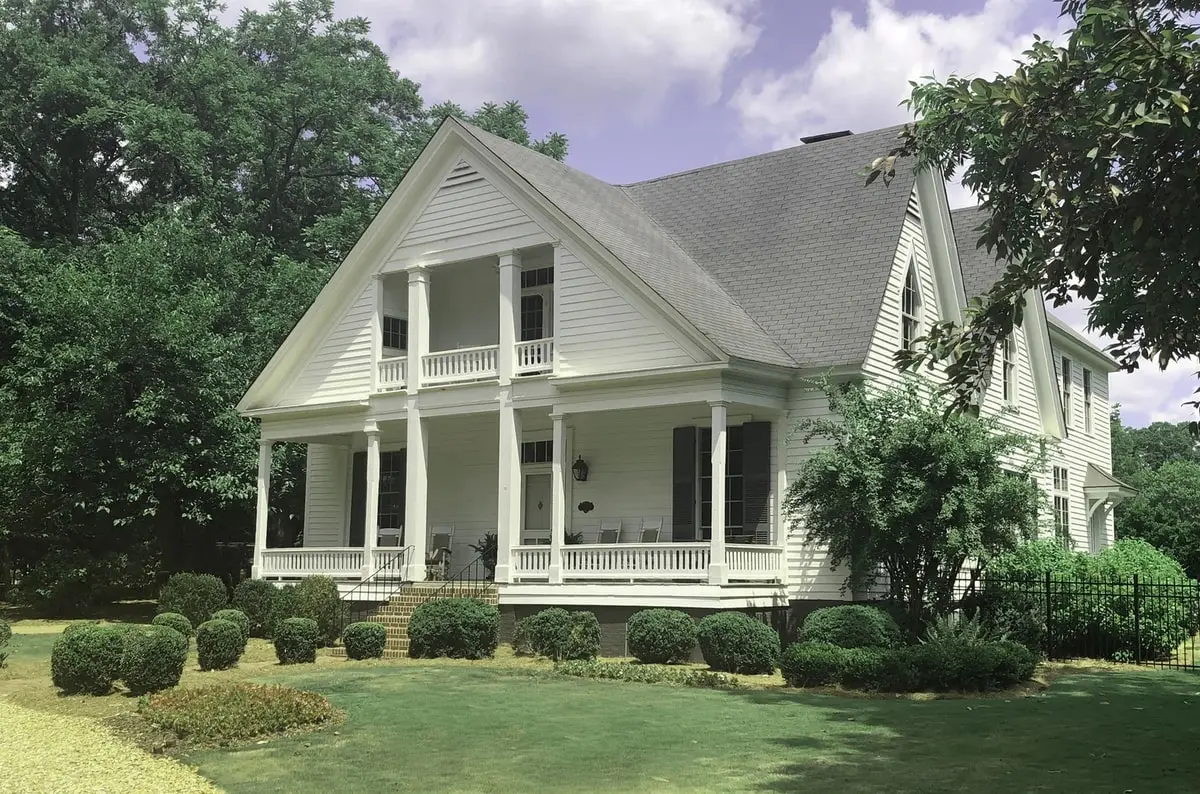
At 2 Cedar Lane, the impressive and somewhat sizeable former home of George Jackson – one of builder Zimri Jackson’s sons – still stands as of this writing (2024). It is not known positively that this home was built by the Jackson brothers, but it carries all the same distinctive Jackson architectural features such as soaring gables and pointed cathedral Gothic Revival windows which were difficult to install and even more difficult to build. It also enjoys the distinction of having been initially owned by Zimri Jackson’s son. (Photo by Olin Jackson)
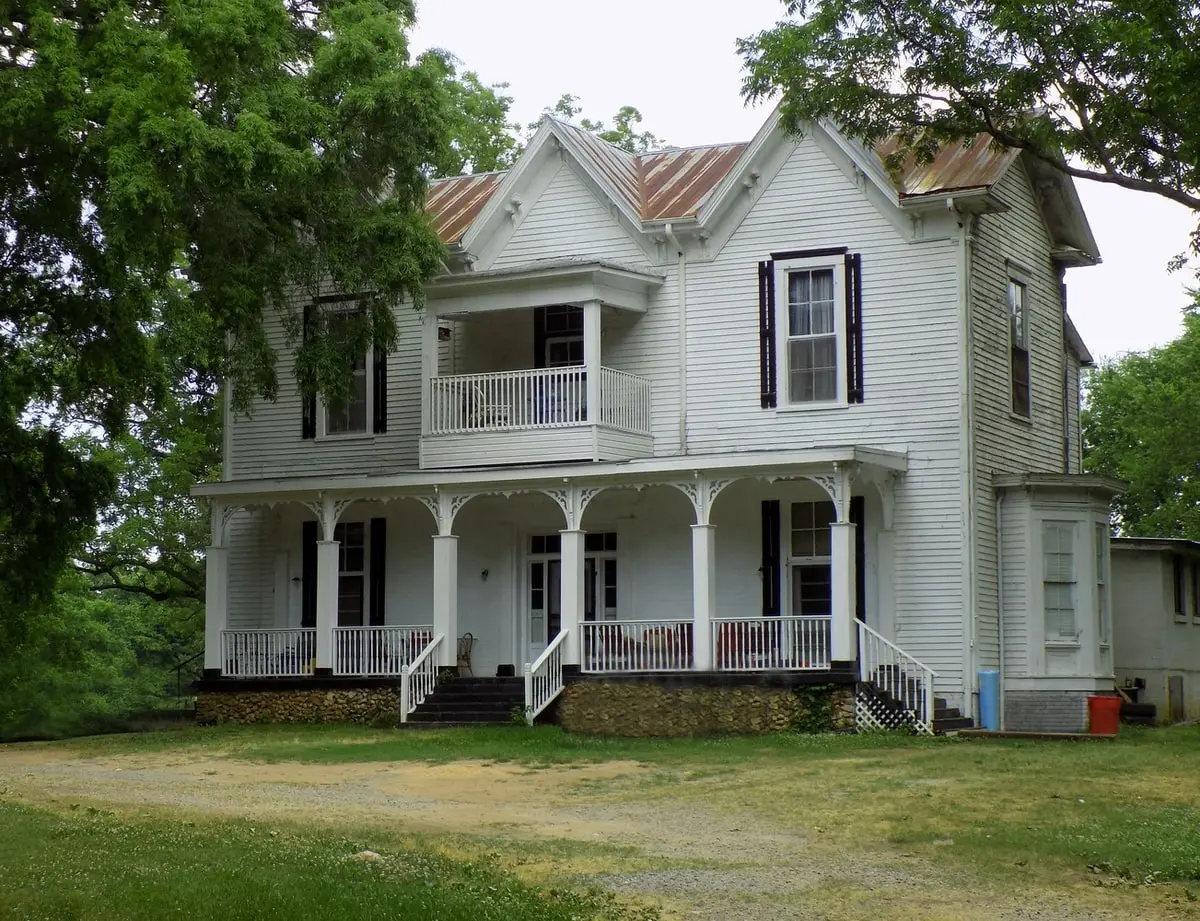
On Mission Road in Bartow, the brothers built Zimri’s son, William Anthony, this classic plantation-style dwelling with its distinctive “planters porch” from which instructions were often given in the mornings to field hands. This home, as of this writing (2024) is still owned by the Jackson family. (Photo by Olin Jackson)
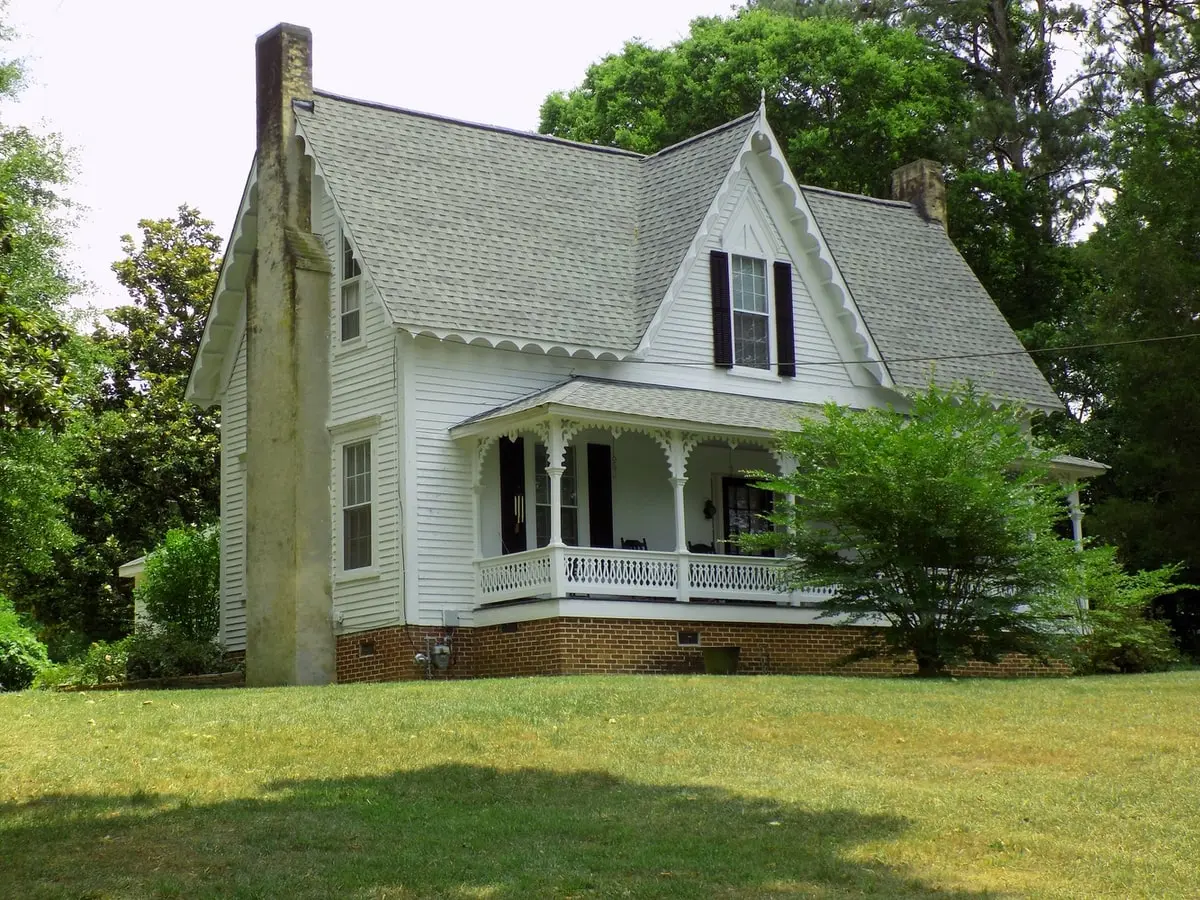
Located at 513 Cassville Road, Zimri built this home for himself in 1861, living here until he died suddenly one morning at the breakfast table. It is one of the few homes in the Cassville, Georgia, vicinity which were not destroyed by contingents of Gen. William Sherman’s troops as they wantonly devastated Georgia in 1864. This structure was also still in the Jackson family as of this writing (2024), owned by Joel and Camille Myers. (Photo by Olin Jackson)
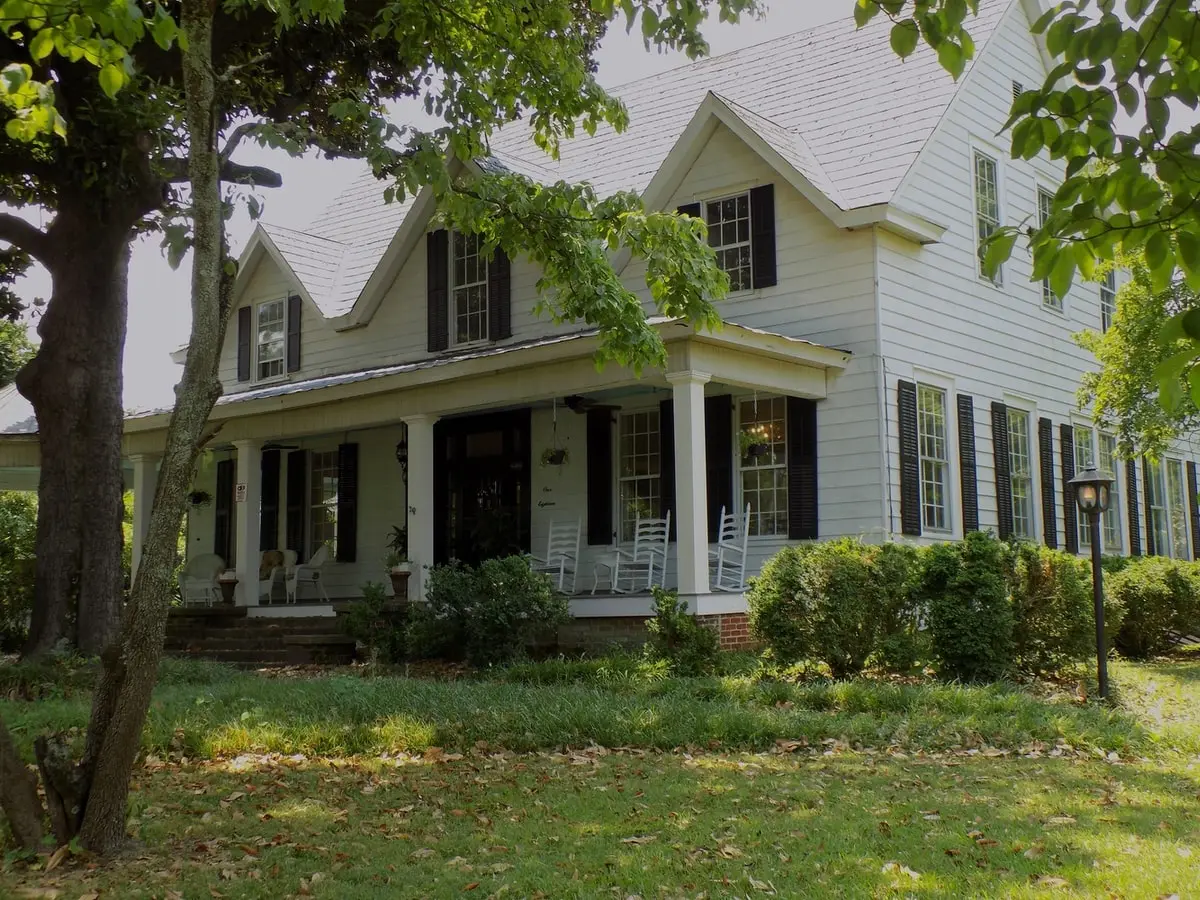
On North Erwin Street in what today is downtown Cartersville, it is believed the structure pictured here was built by the brothers for partner Milton Jackson. The address for Milton’s home was in fact North Erwin, and this home does include many of the distinctive Jackson Brothers construction features. In later years this home was owned by the Rowland family and occupied more recently by Strand’s Salon. (Photo by Olin Jackson)
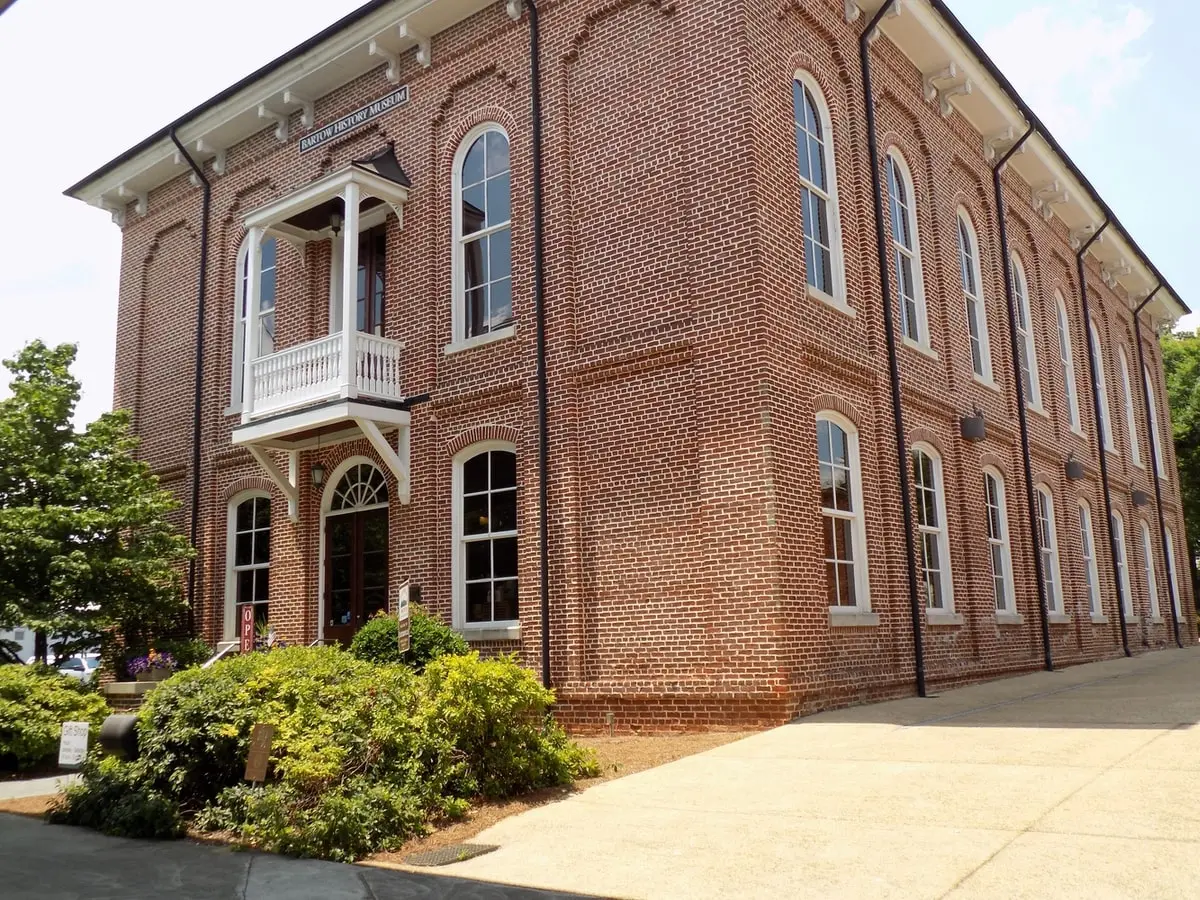
According to the best indications and records, the building firm of Wallis-McElreath began construction of the original Bartow County Courthouse (pictured) in 1867. Following contractual disagreements between them and the county’s building committee, a legal battle ensued and construction ceased in 1868. As can best be determined, in 1870, the Jackson brothers assumed the mantle of builders of the courthouse and construction was renewed, being completed circa 1873. (Photo by Olin Jackson)
